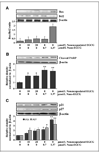Introducing nanochemoprevention as a novel approach for cancer control: proof of principle with green tea polyphenol epigallocatechin-3-gallate
- PMID: 19223530
- PMCID: PMC2950093
- DOI: 10.1158/0008-5472.CAN-08-3978
Introducing nanochemoprevention as a novel approach for cancer control: proof of principle with green tea polyphenol epigallocatechin-3-gallate
Abstract
Chemoprevention, especially through the use of naturally occurring phytochemicals capable of impeding the process of one or more steps of carcinogenesis process, is a promising approach for cancer management. Despite promising results in preclinical settings, its applicability to humans has met with limited success largely due to inefficient systemic delivery and bioavailability of promising chemopreventive agents. Here, we introduce the concept of nanochemoprevention, which uses nanotechnology for enhancing the outcome of chemoprevention. We encapsulated green tea polyphenol epigallocatechin-3-gallate (EGCG) in polylactic acid-polyethylene glycol nanoparticles and observed that encapsulated EGCG retains its biological effectiveness with over 10-fold dose advantage for exerting its proapoptotic and angiogenesis inhibitory effects, critically important determinants of chemopreventive effects of EGCG in both in vitro and in vivo systems. Thus, this study could serve as a basis for the use of nanoparticle-mediated delivery to enhance bioavailability and limit any unwanted toxicity of chemopreventive agents, such as EGCG.
Conflict of interest statement
No potential conflicts of interest were disclosed.
Figures




Similar articles
-
Nanochemoprevention: sustained release of bioactive food components for cancer prevention.Nutr Cancer. 2010;62(7):883-90. doi: 10.1080/01635581.2010.509537. Nutr Cancer. 2010. PMID: 20924964 Free PMC article. Review.
-
Nanochemoprevention by bioactive food components: a perspective.Pharm Res. 2010 Jun;27(6):1054-60. doi: 10.1007/s11095-010-0087-9. Epub 2010 Mar 11. Pharm Res. 2010. PMID: 20221894 Free PMC article.
-
Encapsulated nanoepigallocatechin-3-gallate and elemental selenium nanoparticles as paradigms for nanochemoprevention.Int J Nanomedicine. 2012;7:1711-21. doi: 10.2147/IJN.S29341. Epub 2012 Mar 29. Int J Nanomedicine. 2012. PMID: 22619522 Free PMC article. Review.
-
Oral administration of naturally occurring chitosan-based nanoformulated green tea polyphenol EGCG effectively inhibits prostate cancer cell growth in a xenograft model.Carcinogenesis. 2014 Feb;35(2):415-23. doi: 10.1093/carcin/bgt321. Epub 2013 Sep 26. Carcinogenesis. 2014. PMID: 24072771 Free PMC article.
-
Cancer therapeutics with epigallocatechin-3-gallate encapsulated in biopolymeric nanoparticles.Int J Pharm. 2017 Feb 25;518(1-2):220-227. doi: 10.1016/j.ijpharm.2016.12.030. Epub 2016 Dec 14. Int J Pharm. 2017. PMID: 27988378 Review.
Cited by
-
Green tea component epigallocatechin-3-gallate decreases expression of osteopontin via a decrease in mRNA half-life in cell lines of metastatic hepatocellular carcinoma.Surgery. 2015 Oct;158(4):1039-47; discussion 1047-8. doi: 10.1016/j.surg.2015.06.011. Epub 2015 Jul 17. Surgery. 2015. PMID: 26189955 Free PMC article.
-
The Potential of Phytochemicals in Oral Cancer Prevention and Therapy: A Review of the Evidence.Biomolecules. 2020 Aug 6;10(8):1150. doi: 10.3390/biom10081150. Biomolecules. 2020. PMID: 32781654 Free PMC article. Review.
-
Anticancer activity of flavonoids accompanied by redox state modulation and the potential for a chemotherapeutic strategy.Food Sci Biotechnol. 2021 Mar 20;30(3):321-340. doi: 10.1007/s10068-021-00899-8. eCollection 2021 Mar. Food Sci Biotechnol. 2021. PMID: 33868744 Free PMC article. Review.
-
Broad targeting of angiogenesis for cancer prevention and therapy.Semin Cancer Biol. 2015 Dec;35 Suppl(Suppl):S224-S243. doi: 10.1016/j.semcancer.2015.01.001. Epub 2015 Jan 16. Semin Cancer Biol. 2015. PMID: 25600295 Free PMC article. Review.
-
Impact of nanotechnology in cancer: emphasis on nanochemoprevention.Int J Nanomedicine. 2012;7:591-605. doi: 10.2147/IJN.S26026. Epub 2012 Feb 2. Int J Nanomedicine. 2012. PMID: 22346353 Free PMC article. Review.
References
-
- Murray CJL, Lopez AD, editors. The global burden of disease: a comprehensive assessment of mortality and disability from diseases, injuries and risk factors in 1990 and projected to 2020. Cambridge, MA: Harvard University Press on behalf of the World Health Organization and the World Bank; 1996.
-
- Siddiqui IA, Afaq F, Adhami VM, Mukhtar H. Prevention of prostate cancer through custom tailoring of chemopreventive regimen. Chem Biol Interact. 2008;171:122–132. - PubMed
-
- Nishiyama N. Nanomedicine: nanocarriers shape up for long life. Nat Nanotechnol. 2007;2:203–204. - PubMed
-
- Jemal A, Siegel R, Ward E, et al. Cancer statistics, 2008. CA Cancer J Clin. 2008;58:71–96. - PubMed
-
- Khan N, Afaq F, Saleem M, Ahmad N, Mukhtar H. Targeting multiple signaling pathways by green tea polyphenol (−)-epigallocatechin-3-gallate. Cancer Res. 2006;66:2500–2505. - PubMed
Publication types
MeSH terms
Substances
Grants and funding
LinkOut - more resources
Full Text Sources
Other Literature Sources
Miscellaneous

